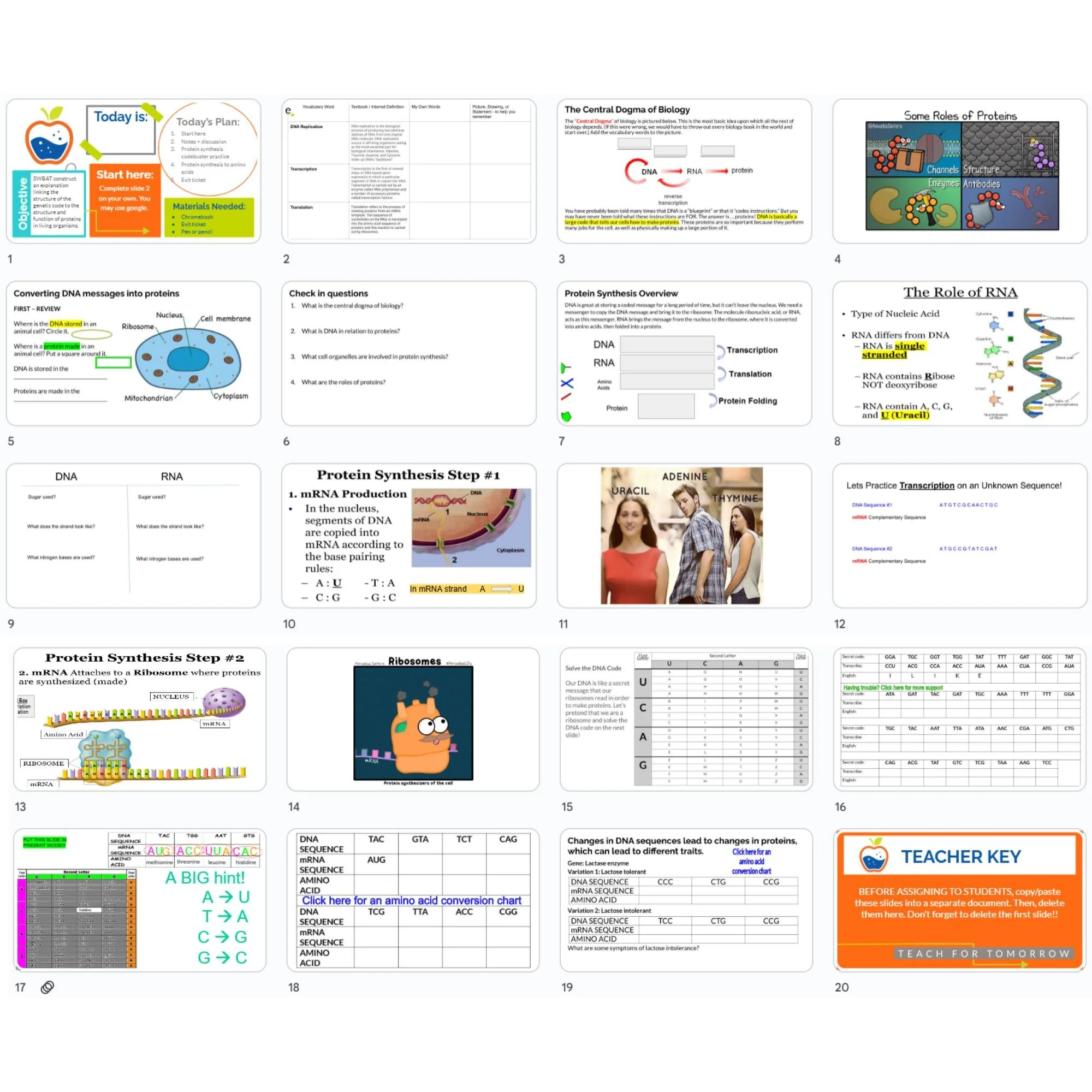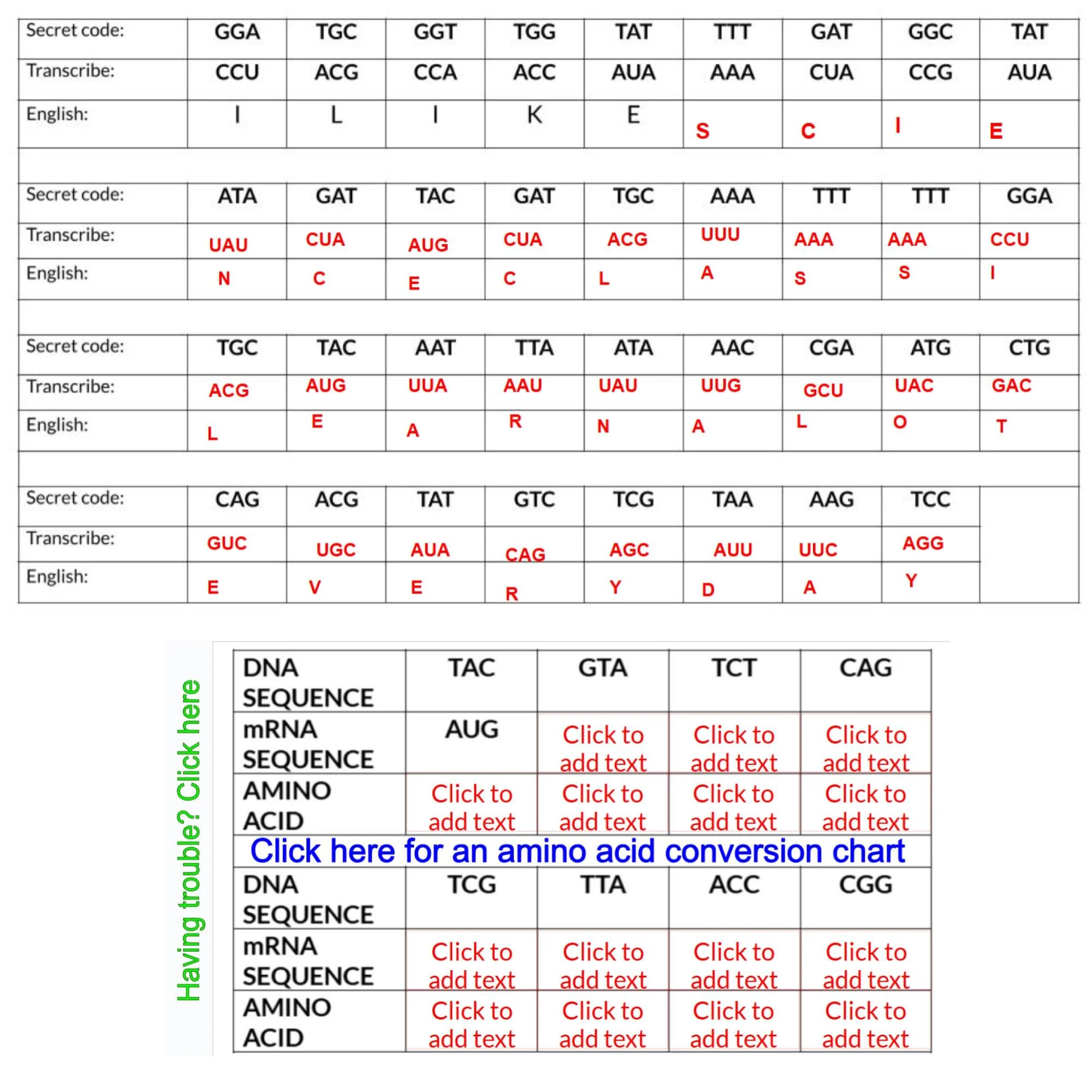



Introduction to Protein Synthesis
Empower Students to Master Protein Synthesis!
A Comprehensive Learning Journey: This interactive lesson is carefully crafted to guide students through the intricacies of protein synthesis. Designed for in person or remote learning, it offers a structured sequence of activities that foster deep comprehension.
Clear Definitions: Students embark on their educational voyage by providing their own interpretations and visuals for key concepts—DNA replication, transcription, and translation. This foundational step ensures a solid grasp of the terminology.
Engaging Interactive Notes: The lesson seamlessly blends textbook definitions with interactive elements. Students place newly acquired vocabulary onto a 'central dogma of biology' diagram, review cellular locations for DNA and protein synthesis, and absorb crucial information about RNA's distinctiveness compared to DNA.
Transcription Proficiency: The lesson dives into the transcription process, emphasizing the pairing of adenine with uracil. Students practice transcribing short DNA strands, reinforcing their understanding of this pivotal step.
Cracking the Code: A modified amino acid conversion chart becomes the key to deciphering a secret message. This engaging activity not only hones conversion skills but also adds an element of fun to the learning process.
Tailored Support: For students needing extra guidance with the conversion chart, an animated slide offers a vivid, step-by-step explanation. This visual aid ensures that every student can master the concept.
Real-Life Application: Students put theory into practice by transcribing and translating actual amino acids, providing a hands-on experience in protein synthesis.
Exploring Mutations: The lesson concludes with an introduction to DNA mutations and their potential to alter proteins, offering a thought-provoking exploration of genetic variation.
Elevate Understanding: Download this comprehensive lesson now to equip your students with a robust understanding of protein synthesis. With its engaging activities and clear explanations, it's a powerful tool for remote or in-person learning environments. Watch as students gain confidence and proficiency in this critical biological process!
Grade & Course Recommendation:
Middle School: Grade 8 Advanced Life Science, foundational molecular biology concepts.
High School: Grades 9–10 Biology, gene expression and central dogma unit.
Cross-Curricular Connections:
ELA Integration: Writing explanatory summaries connecting transcription and translation.
Technology Integration: Use of models or simulations to visualize protein synthesis.
Health Science Integration: Real-world examples like insulin production and genetic disorders.
Daily slide + literacy - based exit ticket included with purchase
Join the Lesson Laboratory and Teach for Tomorrow!
NGSS (Next Generation Science Standards)
High School NGSS Alignment
HS-LS1-1: Construct an explanation based on evidence for how the structure of DNA determines the structure of proteins, which carry out essential life functions through systems of specialized cells.
Connection: Students explicitly trace the pathway from DNA sequence to mRNA to amino acid chain, linking genetic code to protein function.HS-LS3-1: Ask questions to clarify relationships about the role of DNA and chromosomes in coding the instructions for traits passed from parents to offspring.
Connection: Students explore how changes in DNA sequence (mutations) could alter mRNA and protein outcomes.HS-LS1-6: Construct and revise an explanation based on evidence for how carbon, hydrogen, and oxygen from sugar molecules may combine with other elements to form amino acids and other large carbon-based molecules.
Connection: The lesson introduces amino acid formation as a key part of protein synthesis.
Science & Engineering Practices:
Developing and using models (to visualize transcription and translation)
Constructing explanations and designing solutions
Analyzing and interpreting data
Crosscutting Concepts:
Structure and function
Systems and system models
Information flow, feedback, and regulation
Middle School NGSS Connections (for adaptation)
MS-LS3-1: Develop and use a model to describe why structural changes to genes (mutations) may affect proteins and result in harmful, beneficial, or neutral effects.
Connection: Students can model how changes in a DNA sequence lead to different amino acid sequences and potential phenotypic effects.MS-LS3-2: Develop and use a model to describe why sexual reproduction results in genetic variation.
Connection: Students connect gene coding differences to variation at the protein level.
Common Core Standards
Grades 9–10 / 7–8:
CCSS.ELA-LITERACY.RST.9-10.2 / RST.6-8.2: Determine central ideas or conclusions of a text and summarize processes such as transcription and translation.
CCSS.ELA-LITERACY.RST.9-10.4 / RST.6-8.4: Determine the meaning of domain-specific vocabulary (codon, amino acid, translation, ribosome).
CCSS.ELA-LITERACY.RST.9-10.7 / RST.6-8.7: Integrate visual information (base-pairing models and codon tables) with textual explanations.
CCSS.ELA-LITERACY.WHST.9-10.2 / WHST.6-8.2: Write explanatory texts to convey scientific concepts (e.g., describing how DNA codes for proteins).
Empower Students to Master Protein Synthesis!
A Comprehensive Learning Journey: This interactive lesson is carefully crafted to guide students through the intricacies of protein synthesis. Designed for in person or remote learning, it offers a structured sequence of activities that foster deep comprehension.
Clear Definitions: Students embark on their educational voyage by providing their own interpretations and visuals for key concepts—DNA replication, transcription, and translation. This foundational step ensures a solid grasp of the terminology.
Engaging Interactive Notes: The lesson seamlessly blends textbook definitions with interactive elements. Students place newly acquired vocabulary onto a 'central dogma of biology' diagram, review cellular locations for DNA and protein synthesis, and absorb crucial information about RNA's distinctiveness compared to DNA.
Transcription Proficiency: The lesson dives into the transcription process, emphasizing the pairing of adenine with uracil. Students practice transcribing short DNA strands, reinforcing their understanding of this pivotal step.
Cracking the Code: A modified amino acid conversion chart becomes the key to deciphering a secret message. This engaging activity not only hones conversion skills but also adds an element of fun to the learning process.
Tailored Support: For students needing extra guidance with the conversion chart, an animated slide offers a vivid, step-by-step explanation. This visual aid ensures that every student can master the concept.
Real-Life Application: Students put theory into practice by transcribing and translating actual amino acids, providing a hands-on experience in protein synthesis.
Exploring Mutations: The lesson concludes with an introduction to DNA mutations and their potential to alter proteins, offering a thought-provoking exploration of genetic variation.
Elevate Understanding: Download this comprehensive lesson now to equip your students with a robust understanding of protein synthesis. With its engaging activities and clear explanations, it's a powerful tool for remote or in-person learning environments. Watch as students gain confidence and proficiency in this critical biological process!
Grade & Course Recommendation:
Middle School: Grade 8 Advanced Life Science, foundational molecular biology concepts.
High School: Grades 9–10 Biology, gene expression and central dogma unit.
Cross-Curricular Connections:
ELA Integration: Writing explanatory summaries connecting transcription and translation.
Technology Integration: Use of models or simulations to visualize protein synthesis.
Health Science Integration: Real-world examples like insulin production and genetic disorders.
Daily slide + literacy - based exit ticket included with purchase
Join the Lesson Laboratory and Teach for Tomorrow!
NGSS (Next Generation Science Standards)
High School NGSS Alignment
HS-LS1-1: Construct an explanation based on evidence for how the structure of DNA determines the structure of proteins, which carry out essential life functions through systems of specialized cells.
Connection: Students explicitly trace the pathway from DNA sequence to mRNA to amino acid chain, linking genetic code to protein function.HS-LS3-1: Ask questions to clarify relationships about the role of DNA and chromosomes in coding the instructions for traits passed from parents to offspring.
Connection: Students explore how changes in DNA sequence (mutations) could alter mRNA and protein outcomes.HS-LS1-6: Construct and revise an explanation based on evidence for how carbon, hydrogen, and oxygen from sugar molecules may combine with other elements to form amino acids and other large carbon-based molecules.
Connection: The lesson introduces amino acid formation as a key part of protein synthesis.
Science & Engineering Practices:
Developing and using models (to visualize transcription and translation)
Constructing explanations and designing solutions
Analyzing and interpreting data
Crosscutting Concepts:
Structure and function
Systems and system models
Information flow, feedback, and regulation
Middle School NGSS Connections (for adaptation)
MS-LS3-1: Develop and use a model to describe why structural changes to genes (mutations) may affect proteins and result in harmful, beneficial, or neutral effects.
Connection: Students can model how changes in a DNA sequence lead to different amino acid sequences and potential phenotypic effects.MS-LS3-2: Develop and use a model to describe why sexual reproduction results in genetic variation.
Connection: Students connect gene coding differences to variation at the protein level.
Common Core Standards
Grades 9–10 / 7–8:
CCSS.ELA-LITERACY.RST.9-10.2 / RST.6-8.2: Determine central ideas or conclusions of a text and summarize processes such as transcription and translation.
CCSS.ELA-LITERACY.RST.9-10.4 / RST.6-8.4: Determine the meaning of domain-specific vocabulary (codon, amino acid, translation, ribosome).
CCSS.ELA-LITERACY.RST.9-10.7 / RST.6-8.7: Integrate visual information (base-pairing models and codon tables) with textual explanations.
CCSS.ELA-LITERACY.WHST.9-10.2 / WHST.6-8.2: Write explanatory texts to convey scientific concepts (e.g., describing how DNA codes for proteins).